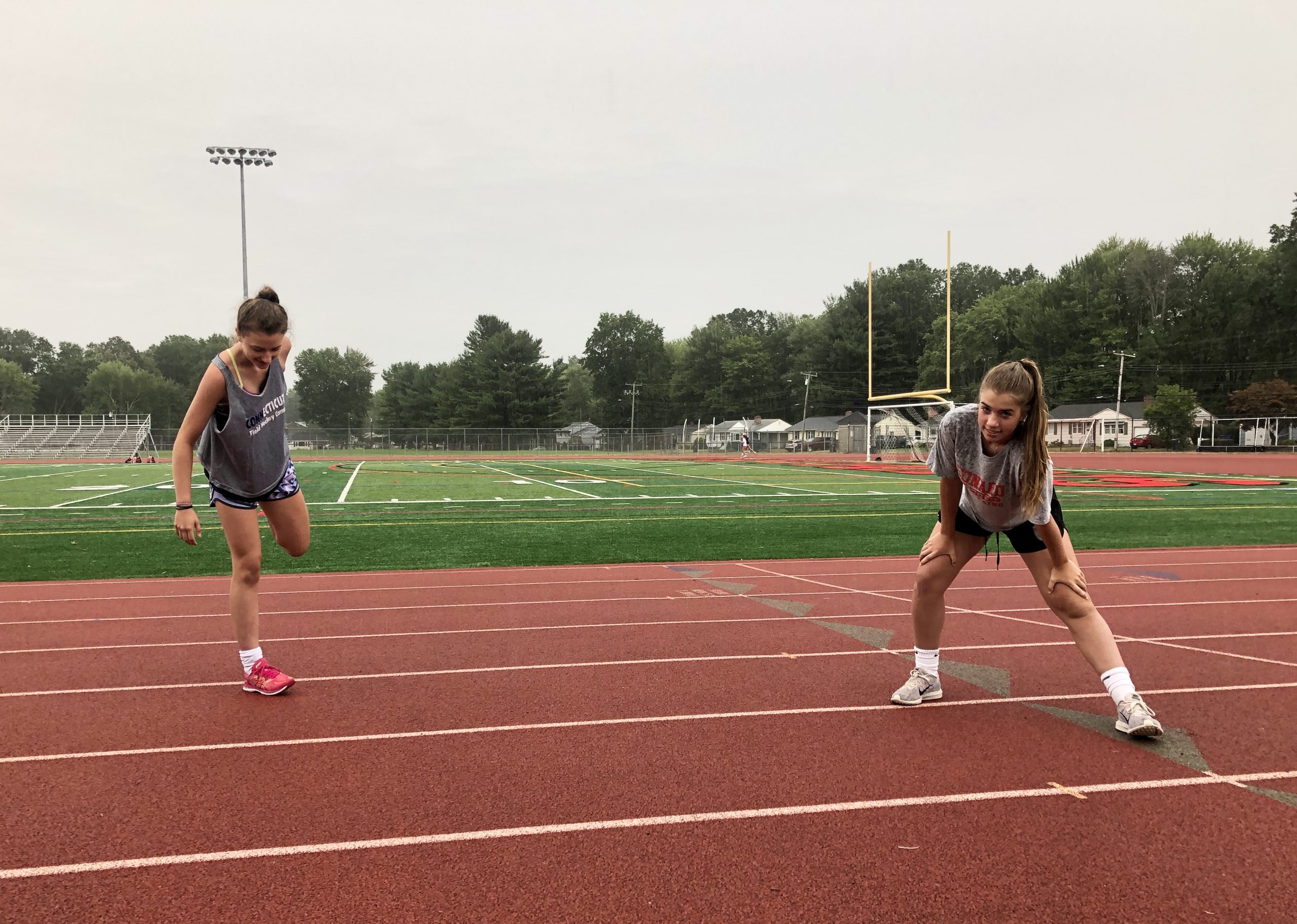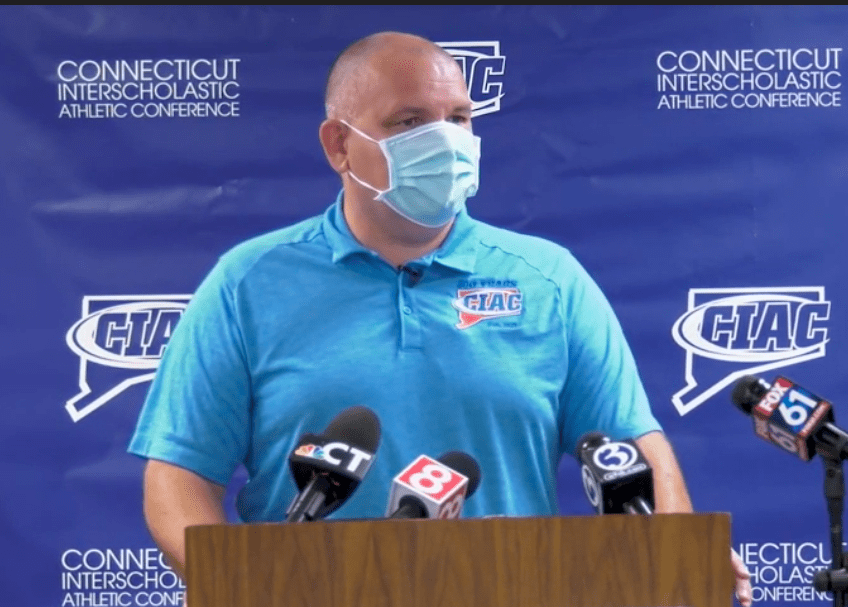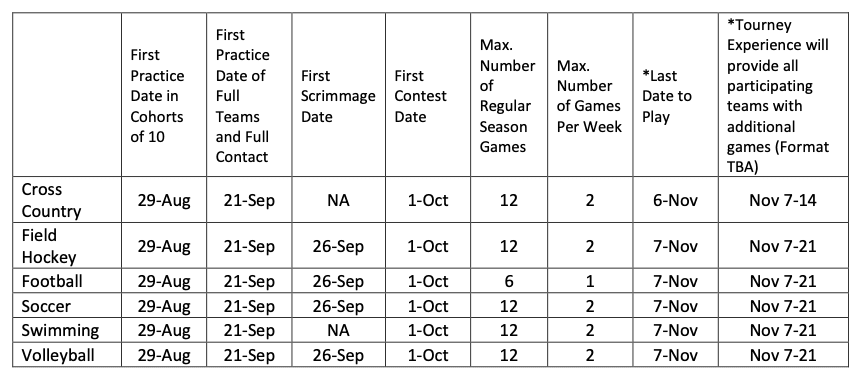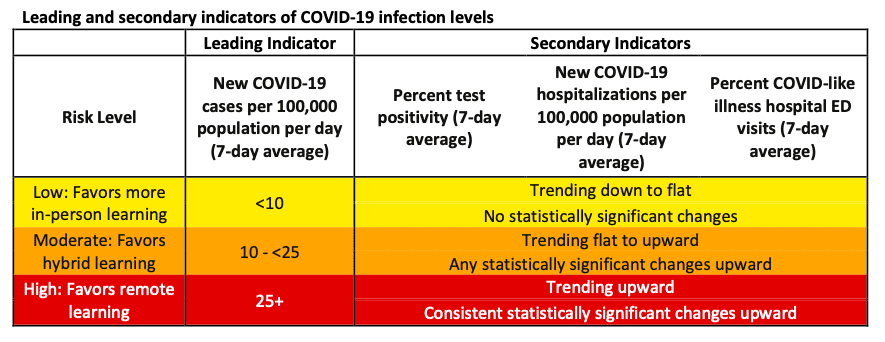CIAC Announces Fall Seasons to Proceed, Including Football and Volleyball

Audio By Carbonatix

A Conard High School field hockey player (left) and soccer player warm up on the school's track Thursday morning prior to doing some conditioning. Photo credit: Ronni Newton
Fall sports teams at West Hartford’s Conard and Hall high schools are set to begin small cohort practices on Saturday, Aug. 29, but the superintendent says that further guidance from the Department of Public Health and the West Hartford-Bloomfield Health District will determine a final decision on the seasons for all sports.

Glenn Lungarini, executive director of the CIAC, speaks at a press briefing Thursday morning. (Screenshot)
By Ronni Newton
The next step toward having fall high school sports seasons will take place Saturday, following the Central Connecticut Athletic Conference’s (CIAC) official announcement Thursday that all fall sports may begin practice in cohorts of 10 beginning Aug. 29.
The CIAC had given permission late Sunday for high schools to be able to resume conditioning for fall sports, which had been paused since Aug. 14, in cohorts of 10 students, as of Monday, Aug. 24.
The CIAC said Thursday that the organization and the state Department of Public Health (DPH) are in agreement that “pre-season conditioning is a critical safety component for high school athletes prior to the start of any practice activities, to both reduce the prevalence of sports-related injuries throughout the season and to offer an important period of acclimatization to prevent heat-related illnesses.”
DPH is also in support of moving forward with conditioning activities as well as sport-specific non-contact drills for all sports – activities that are deemed low risk – as appropriate for the first two weeks of the 2020-2021 school year.
“Our athletes have been doing conditioning work in small groups with our coaches in a safe way, and it has gone very well and will continue,” West Hartford Superintendent of Schools Tom Moore told We-Ha.com on Thursday morning.
In an Aug. 26 update posted on its website, the CIAC noted that Sept. 21, 2020, was determined to be the date that most member schools will have been in session for two weeks, and the target date for the next phase of activity.

CIAC fall sports plan updated Aug. 26, 2020.
“The CIAC believes that a minimum of two weeks of COVID data is necessary to determine whether the return to on campus instruction will impact extracurricular offerings,” the organization stated. It plans to review COVID data as of Sept. 18, and if the metrics remain in the “low” category – the current status – the CIAC will permit full team practices to begin Sept. 21, with contests beginning Oct. 1.

CIAC handout
The CIAC acknowledges that giving the green light to all fall sports, including the higher risk sports of indoor girls volleyball (rated a moderate-risk indoor activity) and 11 vs. 11 full contact football (rated a high-risk outdoor activity), is counter to the current recommendations of DPH for school sports.
“We want to stress to everybody the fluidity of our plan,” CIAC Executive Director Glenn Lungarini said as he outlined the updates to the fall plan during a press briefing Thursday morning.
“We really see our plan at this point as trying to align as much as possible with DPH … as we enter into the fall sports starting on Saturday we go in with every sport experience being low risk,” said Lungarini, with 60 minutes of practice for each sport permitted, of which 30 minutes is conditioning and 30 minutes is non-contact skills practice.
Lungarini said DPH has expressed support for moving to full team and contact practices two weeks after school started, with the exception of indoor volleyball and football, for which they offered suggestions to lower the risks such as playing volleyball outdoors and football in a 7 vs. 7 no-tackle method.
The DPH recommendations for volleyball and football, Lungarini said, are inconsistent with the ReOpenCT guidelines for non-interscholastic sports. Higher risk sports were allowed to resume as of July 6, he said, and have been happening safely.
“One of the areas that we continue to discuss is the inconsistent position of what is allowed in the private sector and what is allowed for public schools,” Lungarini said Thursday. The CIAC also “continues to seek an understanding from DPH on the specific quantitative COVID data it is using to support its qualitative position on volleyball and football.”
More details, including the CIAC’s sport-specific guidelines, can be found here.
West Hartford plans
“The Connecticut Department of Public Health agreed with CIAC regarding the start of sports with the exceptions of volleyball and football,” Moore said.
“While the CIAC can say full steam ahead and ignore the Department of Public Health, we as a school district cannot. Since there is time, our focus is on opening schools safely, and we will seek further input and clarification from the Connecticut Department of Public Health and the West Hartford-Bloomfield Health District before any final decisions are made,” Moore added. “Workouts can and will continue.”
Moore said he believes other superintendents throughout the state will also look toward the DPH and their local health departments before finalizing plans.
Moore has a personal connection to sports, and in particular to the two sports that are considered higher risk.
“I am well aware of the importance of sports and activities in the lives of our students,” he said. “My son was quarterback for Conard and my daughter was a volleyball captain just last year. The best professional development I had and training to be a leader was my time coaching football, baseball, and girls lacrosse at Conard. There aren’t many superintendents anywhere that love sports the way I do. Like everything else with the pandemic there are no easy decisions here, and no matter the end result, some will be angry. But we will seek the detailed advice of our public health officials before making any final decisions.”
West Hartford Athletic Director Jason Siegal said he is already finishing the schedule for teams to begin practice in accordance with CIAC, DPH, and district guidelines.
“We will continue moving forward until someone tells me we can’t move forward,” Siegal said, noting that conversations have been taking place all along.
“We have practice set for Saturday and moving into next week with the constraints of only 60 minutes of activity,” Siegal said Thursday.
Practices on Saturday will take place between 8 a.m.-12:30 p.m., with an hour allotted for each team and a 10-minute transition time.
“We are working to devise traffic flows throughout campus,” he said, and to keep cohorts together within teams.
Siegal noted that student athletes will be required to wear masks or face coverings other than when they are on the field or engaged in strenuous activity. They should bring their own masks, which should be worn as soon as they set foot on campus, but in case anyone forgets, extras are available.
As of now, spectators, including parents, are not permitted at practices. It should only be the team members, coaches, and trainers on the campus. The CIAC has stated that the decision to allow spectators at games is up to each district, and issue will continue to be discussed in West Hartford, Siegal said.
Siegal said that West Hartford is working to implement the plans as best as possible. “I hope we get the kids back to school, and get into some game play,” he said.
“Our goal is to get the kids back to the classroom, and athletics is part of the classroom experience,” Siegal said. There will not be any state tournaments or conference championships this fall, but the kids need to be with their peers, need the positive experience.
“Rest assured that we are doing what we can to keep everyone safe,” Siegal said.
Timing of decisions, and future impact
Lungarini said Thursday that he understands that getting kids back to school may result in higher metrics, and that’s the reason that the fall sports plan includes low-risk sport-specific practice activities until students have been back in school for several weeks.
The plan for fall sports put forth by the CIAC on July 31 had the student-athletes engaged in only low-risk activities through Sept. 11, but now that many districts have pushed back the start of school until just after Labor Day, “we pushed that timeframe for teams to get together. .. we agree that shouldn’t happen. until two weeks after,” Lungarini said.
He said the CIAC will consider whether or not the metrics will support increased activity before moving onto the next phase. “We’ve been consistent in looking at that since March,” Lungarini said.
“We want very clear, our message to be, that we are listening to the messages that are coming from the department of health,” Lungarini said. While they are aligning in many ways with DPH, he said, there are still some questions.
“We’re trying to provide our districts and our superintendents with as much information as possible,” said Lungarini.
DPH will not be issuing a response to either the update to the fall sports plan posted on the CIAC website Wednesday night or the statements made during Thursday’s press conference.
“We made our recommendations well known to CIAC and many in-depth conversations with CIAC and various coaches, athletic trainers, and physicians,” spokesperson Av Harris said in an email to We-Ha.com on Thursday. “The decision on how to proceed was always up to the CIAC and individual school districts. DPH is happy to be a partner and resource as we move forward.”
During a Thursday afternoon press briefing with Gov. Ned Lamont, Acting DPH Commissioner Dr. Deidre Gifford reiterated the health department’s recommendations “that we don’t recommend going ahead with high risk sports like football or moderate risk indoor sports like volleyball.” The recommendations are based on the nature of sports and the manner in which coronavirus is transmitted, she said.
Lungarini stressed Thursday that even football and volleyball are beginning with low risk activities, but would like to have time to make the decision to play 11 v. 11 football if the metrics continue to be positive once school begins.
Football, he said, is “unique that there is not really that club or that AAU experience for kids.” Having the high school season may be the only opportunity available for kids who are being recruited.
“As we move into the winter or spring it’s anticipated that there will be an uptick in the covid metrics,” Lungarini said. “Now may be the only opportunity to provide kids the experience.”
Supporting the “mental health, social and emotional well-being” of student athletes through structured physical activity and relationships with coaches and peers is also important, Lungarini said.
Coaches motivate and encourage kids to “commit to school, your family, and this team,” which could prevent them from engaging in riskier social activities.
With the starting point being a cohort of 10, Lungarini said, coaches could easily align the practice groups with existing cohorts, and even if the status moves to orange/moderate risk, some sports experience could still continue through those cohorts.
If the metrics reach the high risk/red zone, “then we would stop sport activity at that time,” Lungarini said.
He also think it’s important to consider how the decision made now impacts future sports seasons, particularly the winter seasons, and the CIAC wants to give the student athletes the best opportunities it can.
While swimming is low risk, basketball and hockey are considered high risk, and due to the number of participants indoor track is moderate risk. The sharing of equipment elevates gymnastics to a higher-risk sport as well.
“If we were to make that decision right now to say we can’t play those sports … we would be making that decision essentially through the winter season,” Lungarini said. “We feel they deserve the time and deserve the opportunity to at least begin with low risk activities and then make a decision. …We think it’s safe, we think it’s logical, we think it gives a progression,” he said, and provides information to superintendents and boards of education so they can make a decision.
Like what you see here? Click here to subscribe to We-Ha’s newsletter so you’ll always be in the know about what’s happening in West Hartford! Click the blue button below to become a supporter of We-Ha.com and our efforts to continue producing quality journalism.




[…] of the teachers and staff also coach sports teams, and practices began on Saturday with conditioning and sport-specific skill training in cohorts of […]
[…] new energy had started to blossom throughout the hungry student-athletes here in Connecticut with news at the end of August that officials at the Connecticut Interscholastic Athletic Conference may …. “Yesterday at practice was the first day of pads,” Edwards said. “Everything finally seemed […]
[…] After a pause in mid-August, the CIAC announced Aug. 30 that practices for all fall sports could resume on Aug. 31. […]